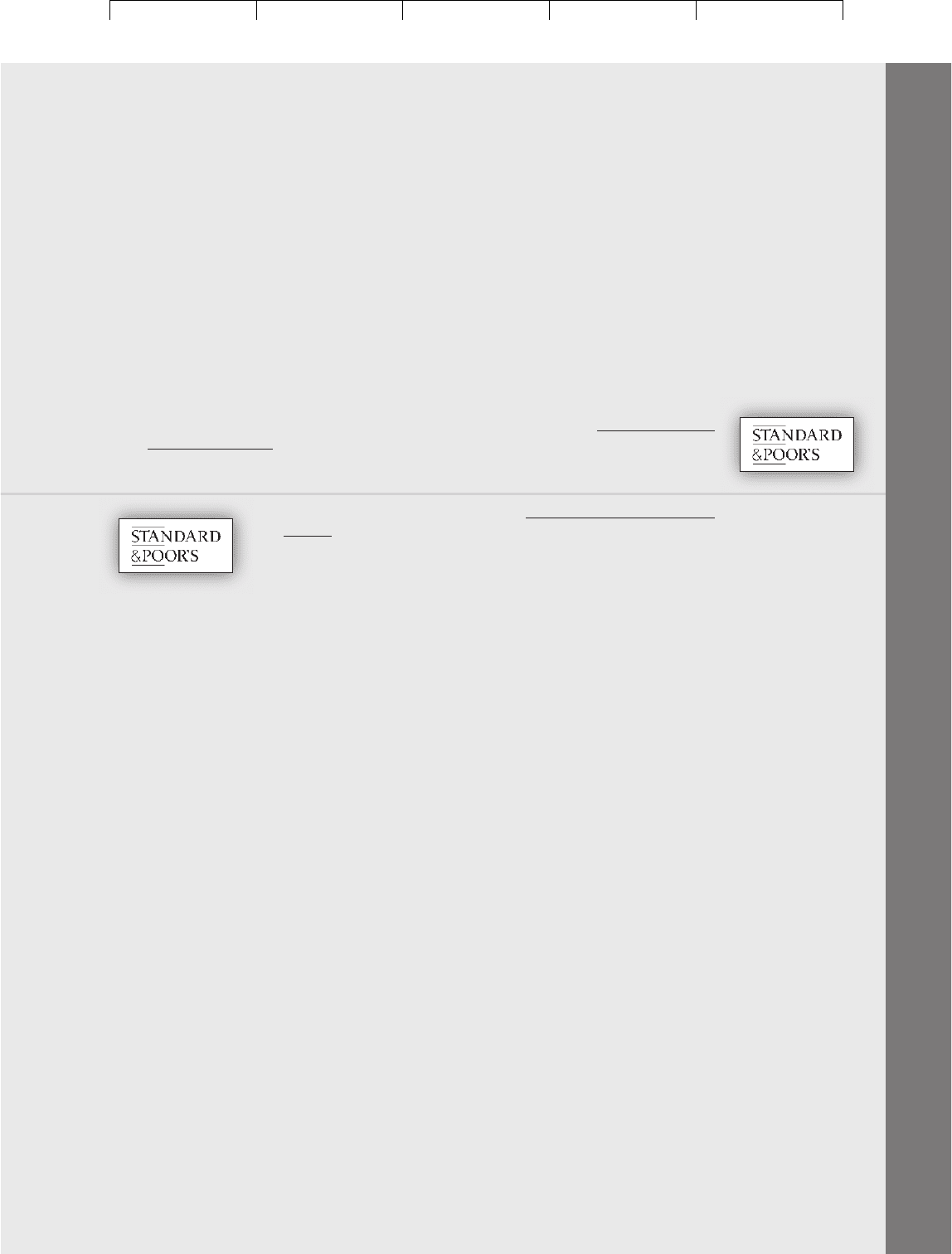Brealey, Myers. Principles of Corporate Finance. 7th edition
Подождите немного. Документ загружается.


Brealey−Meyers:
Principles of Corporate
Finance, Seventh Edition
V. Dividend Policy and
Capital Structure
18. How Much Should A
Firm Borrow
© The McGraw−Hill
Companies, 2003
CHAPTER 18 How Much Should a Firm Borrow? 521
15. Suppose the trade-off theory of capital structure is true. Can you predict how compa-
nies’ debt ratios should change over time? How do these predictions differ from the
pecking-order theory’s?
16. Summarize the evidence pro and con the pecking-order theory of capital structure.
17. “Why are personal taxes on bond interest important? They are the bondholder’s prob-
lem.” Explain why they are also indirectly the shareholder’s problem.
18. The possible payoffs from Ms. Ketchup’s projects (see Section 18.3) have not changed
but there is now a 40 percent chance that project 2 will pay off $24 and a 60 percent
chance that it will pay off $0.
a. Recalculate the expected payoffs to the bank and Ms. Ketchup if the bank lends the
present value of $10. Which project would Ms. Ketchup undertake?
b. What is the maximum amount the bank could lend that would induce Ms.
Ketchup to take project 1?
19. Select a dozen companies from the Market Insight database (www
.mhhe.com/
edumarketinsight). Estimate how much more these companies could borrow before
they would exhaust taxable profits.
CHALLENGE
QUESTION
1. Use the Market Insight database (www.mhhe.com/edumarket
insight) to see how well differences in company leverage seem to
support the trade-off theory and the pecking-order theory.
Visit us at www.mhhe.com/bm7e

Brealey−Meyers:
Principles of Corporate
Finance, Seventh Edition
V. Dividend Policy and
Capital Structure
19. Financing and
Valuation
© The McGraw−Hill
Companies, 2003
CHAPTER NINETEEN
522
FINANCING AND
V A L U A T I O N

Brealey−Meyers:
Principles of Corporate
Finance, Seventh Edition
V. Dividend Policy and
Capital Structure
19. Financing and
Valuation
© The McGraw−Hill
Companies, 2003
WE FIRST ADDRESSED problems of capital budgeting in Chapter 2. At that point we said hardly a
word about financing decisions; we proceeded under the simplest possible assumption about fi-
nancing, namely, all-equity financing. We were really assuming an idealized Modigliani–Miller (MM)
world in which all financing decisions are irrelevant. In a strict MM world, firms can analyze real in-
vestments as if they are to be all-equity-financed; the actual financing plan is a mere detail to be
worked out later.
Under MM assumptions, decisions to spend money can be separated from decisions to raise
money. In this chapter we reconsider the capital budgeting decision when investment and financing
decisions interact and cannot be wholly separated.
In the early chapters you learned how to value a capital investment opportunity by a four-step
procedure:
1. Forecast the project’s incremental after-tax cash flow, assuming the project is entirely equity-
financed.
2. Assess the project’s risk.
3. Estimate the opportunity cost of capital, that is, the expected rate of return offered to investors
by the equivalent-risk investments traded in capital markets.
4. Calculate NPV, using the discounted-cash-flow formula.
In effect, we were thinking of each project as a mini-firm, and asking, How much would that mini-firm
be worth if we spun it off as a separate, all-equity-financed enterprise? How much would investors
be willing to pay for shares in the project?
Of course, this procedure rests on the concept of value additivity. In well-functioning capital mar-
kets the market value of the firm is the sum of the present value of all the assets held by the firm
1
—
the whole equals the sum of the parts.
In this chapter we stick with the value-additivity principle but extend it to include value contributed
by financing decisions. There are two ways of doing this:
1. Adjust the discount rate. The adjustment is typically downward, to account for the value of inter-
est tax shields. This is the most common approach. It is usually implemented via the after-tax
weighted-average cost of capital or “WACC.”
2. Adjust the present value. That is, start by estimating the project’s “base-case” value as an all-
equity-financed mini-firm, and then adjust this base-case NPV to account for the project’s impact
on the firm’s capital structure. Thus
Once you identify and value the side effects of financing a project, calculating its APV (adjusted net
present value) is no more than addition or subtraction.
This is a how-to-do-it chapter. In the next section, we explain and derive the after-tax weighted-
average cost of capital, reviewing required assumptions and the too-common mistakes people make
using this formula. Section 19.2 then covers the tricks of the trade: helpful tips on how to estimate
continued
NPV of financing decisions caused by project acceptance
Adjusted NPV 1APV for short2 base-case NPV
523
1
All assets means intangible as well as tangible assets. For example, a going concern is usually worth more than a haphazard pile
of tangible assets. Thus, the aggregate value of a firm’s tangible assets often falls short of its market value. The difference is ac-
counted for by going-concern value or by other intangible assets such as accumulated technical expertise, an experienced sales
force, or valuable growth opportunities.

Brealey−Meyers:
Principles of Corporate
Finance, Seventh Edition
V. Dividend Policy and
Capital Structure
19. Financing and
Valuation
© The McGraw−Hill
Companies, 2003
Think back to Chapter 17 and Modigliani and Miller’s (MM’s) proposition I. MM
showed that, without taxes or financial market imperfections, the cost of capital
does not depend on financing. In other words, the weighted average of the ex-
pected returns to debt and equity investors equals the opportunity cost of capital,
regardless of the debt ratio:
Here r is the opportunity cost of capital, the expected rate of return investors would
demand if the firm had no debt at all; and are the expected rates of return on
debt and equity, the “cost of debt” and “cost of equity.” The weights D/V and E/V
are the fractions of debt and equity, based on market values; V, the total market
value of the firm, is the sum of D and E.
But you can’t look up r, the opportunity cost of capital, in The Wall Street Journal
or find it on the Internet. So financial managers turn the problem around: They
start with the estimates of and and then infer r. Under MM’s assumptions,
This formula calculates r, the opportunity cost of capital, as the expected rate of re-
turn on a portfolio of all the firm’s outstanding securities.
r r
D
D
V
r
E
E
V
r
E
r
D
r
E
r
D
r, a constant, independent of D/V
Weighted-average return to debt and equity r
D
D
V
r
E
E
V
524 PART V
Dividend Policy and Capital Structure
inputs and how the formula is used in practice. Section 19.3 shows how to recalculate the weighted-
average cost of capital when capital structure or asset mix changes.
Section 19.4 turns to the Adjusted Present Value or APV method. This is simple enough in con-
cept: Just value the project by discounting at the opportunity cost of capital—not the WACC—
and then add the present values gained or lost due to financing side effects. But identifying and
valuing the side effects is sometimes tricky, so we’ll have to work through some numerical
examples.
Section 19.5 reexamines a basic and apparently simple issue: What should the discount rate be
for a risk-free project? Once we recognize the tax deductibility of debt interest, we will find that
all risk-free, or debt-equivalent, cash flows can be evaluated by discounting at the after-tax inter-
est rate. We show that this rule is consistent with both the weighted-average cost of capital and
with APV.
We conclude the chapter with a question and answer section designed to clarify points that man-
agers and students often find confusing. An Appendix providing more details and more formulas can
be obtained from the Brealey–Myers website.
2
2
www.mhhe.com/bm7e.
19.1 THE AFTER-TAX WEIGHTED-AVERAGE COST
OF CAPITAL

Brealey−Meyers:
Principles of Corporate
Finance, Seventh Edition
V. Dividend Policy and
Capital Structure
19. Financing and
Valuation
© The McGraw−Hill
Companies, 2003
We have discussed this weighted-average cost of capital formula in Chapters 9
and 17. However, the formula misses a crucial difference between debt and equity:
Interest payments are tax-deductible. Therefore we move on to the after-tax
weighted-average cost of capital, nicknamed WACC:
Here is the marginal corporate tax rate.
Notice that the after-tax WACC is less than the opportunity cost of capital (r), be-
cause the “cost of debt” is calculated after tax as . Thus the tax advantages
of debt financing are reflected in a lower discount rate. Notice too that all the variables
in the weighted-average formula refer to the firm as a whole. As a result, the formula
gives the right discount rate only for projects that are just like the firm undertaking
them. The formula works for the “average” project. It is incorrect for projects that are
safer or riskier than the average of the firm’s existing assets. It is incorrect for projects
whose acceptance would lead to an increase or decrease in the firm’s debt ratio.
Example: Sangria Corporation
Let’s calculate WACC for the Sangria Corporation. Its book and market value bal-
ance sheets are
r
D
11 T
c
2
T
c
WACC r
D
11 T
c
2
D
V
r
E
E
V
CHAPTER 19 Financing and Valuation 525
Sangria Corporation (Book Values, millions)
Asset value $100 $ 50 Debt
50 Equity
$100 $100
Sangria Corporation (Market Values, millions)
Asset value $125 $ 50 Debt (D)
75 Equity (E)
$125 $125 Firm Value (V)
We calculated the market value of equity on Sangria’s balance sheet by multiply-
ing its current stock price ($7.50) by 10 million, the number of its outstanding
shares. The company has done well and future prospects are good, so the stock is
trading above book value ($5.00 per share). However, the book and market values
of Sangria’s debt are in this case equal.
Sangria’s cost of debt (the interest rate on its existing debt and on any new bor-
rowing) is 8 percent. Its cost of equity (the expected rate of return demanded by in-
vestors in Sangria’s stock) is 14.6 percent.
The market value balance sheet shows assets worth $125 million. Of course we
can’t observe this value directly, because the assets themselves are not traded. But
we know what they are worth to debt and equity investors ( mil-
lion). This value is entered on the left of the market value balance sheet.
Why did we show the book balance sheet? Only so you could draw a big X
through it. Do so now.
When estimating the weighted-average cost of capital, you are not interested
in past investments but in current values and expectations for the future. San-
gria’s true debt ratio is not 50 percent, the book ratio, but 40 percent, because its
50 75 $125

Brealey−Meyers:
Principles of Corporate
Finance, Seventh Edition
V. Dividend Policy and
Capital Structure
19. Financing and
Valuation
© The McGraw−Hill
Companies, 2003
The company’s WACC is
That’s how you calculate the weighted-average cost of capital.
3
Now let’s see how Sangria would use this formula. Sangria’s enologists have
proposed investing $12.5 million in construction of a perpetual crushing ma-
chine, which, conveniently for us, never depreciates and generates a perpetual
stream of earnings and cash flow of $2.085 million per year pretax. The after-tax
cash flow is
WACC .0811 .352
1.42 .1461.62 .1084, or 10.84%
526 PART V Dividend Policy and Capital Structure
3
In practice it’s pointless to calculate discount rates to four decimal places. We do so here to avoid
confusion from rounding errors. Earnings and cash flows are carried to three decimal places for the
same reason.
Pretax cash flow $2.085
Tax at 35% .730
After-tax cash flow $1.355 million
Notice: This after-tax cash flow takes no account of interest tax shields on debt sup-
ported by the perpetual crusher project. As we explained in Chapter 6, standard
capital budgeting practice calculates after-tax cash flows as if the project were all-
equity-financed. However, the interest tax shields will not be ignored: We are about
to discount the project cash flows by Sangria’s WACC, in which the cost of debt is
entered after tax. The value of interest tax shields is picked up not as higher after-
tax cash flows, but in a lower discount rate.
The crusher generates a perpetual cash flow of million, so NPV is
means a barely acceptable investment. The annual cash flow of $1.355 mil-
lion per year amounts to a 10.84% rate of return on investment ( ),
exactly equal to Sangria’s WACC.
If project , the return to equity investors must exactly equal the cost of
equity, 14.6%. Let’s confirm that Sangria shareholders could actually forecast a
14.6% return on their investment in the perpetual crusher project.
NPV 0
1.355/12.5 .1084
NPV 0
NPV 12.5
1.355
.1084
0
C $1.355
Cost of debt ( ) .08
Cost of equity ( ) .146
Marginal tax rate ( ) .35
Debt ratio (D/V)
Equity ratio (E/V)75/125 .6
50/125 .4
T
c
r
E
r
D
assets are worth $125 million. The cost of equity, , is the expected rate
of return from purchase of stock at $7.50 per share, the current market price. It
is not the return on book value per share. You can’t buy shares in Sangria for $5
anymore.
Sangria is consistently profitable and pays tax at the marginal rate of 35 percent.
That is the final input for Sangria’s WACC. The inputs are summarized here:
r
E
.146

Brealey−Meyers:
Principles of Corporate
Finance, Seventh Edition
V. Dividend Policy and
Capital Structure
19. Financing and
Valuation
© The McGraw−Hill
Companies, 2003
Calculate the expected dollar return to shareholders:
The project’s earnings are level and perpetual, so the expected rate of return on eq-
uity is equal to the expected equity income divided by the equity value:
The expected return on equity equals the cost of equity, so it makes sense that the
project’s NPV is zero.
Review of Assumptions
By discounting the perpetual crusher’s cash flows at Sangria’s WACC, we as-
sume that
• The project’s business risks are the same as Sangria’s other assets.
• The project supports the same fraction of debt to value as in Sangria’s overall
capital structure.
You can see the importance of these two assumptions: If the perpetual crusher had
greater business risk than Sangria’s other assets, or if acceptance of the project
would lead to a permanent, material
4
change in Sangria’s debt ratio, then Sangria’s
shareholders would not be content with a 14.6 percent expected return on their eq-
uity investment in the project.
We have illustrated the WACC formula only for a project offering perpetual
cash flows. But Miles and Ezzell have shown that the formula works for any
cash-flow pattern if the firm adjusts its borrowing to maintain a constant debt ra-
tio over time. When the firm departs from this borrowing policy, WACC is only
approximately correct.
5
1.095
7.5
.146, or 14.6%
Expected equity return r
E
expected equity income
equity value
Expected equity income C 11 T
c
2r
D
D 1.355 .26 1.095
After-tax interest r
D
11 T
c
2D .0811 .352 152 .26
CHAPTER 19 Financing and Valuation 527
Perpetual Crusher (Market Values, millions)
Project value $12.5 $ 5.0 Debt (D)
7.5 Equity (E)
$12.5 $12.5 Project Value (V)
4
Users of WACC need not worry about small or temporary fluctuations in debt-to-value ratios.
Suppose that Sangria management decided for convenience to borrow $12.5 million to allow im-
mediate construction of the crusher. This does not necessarily change Sangria’s long-term financ-
ing policy. If the crusher supports only $5.0 million of debt, Sangria would have to pay down debt
to restore its overall debt ratio to 40 percent. For example, it could fund later projects with less debt
and more equity.
5
J. Miles and R. Ezzell, “The Weighted Average Cost of Capital, Perfect Capital Markets, and Project
Life: A Clarification,” Journal of Financial and Quantitative Analysis 15 (September 1980), pp. 719–730.
Suppose Sangria sets up this project as a mini-firm. Its market-value balance
sheet looks like this:

Brealey−Meyers:
Principles of Corporate
Finance, Seventh Edition
V. Dividend Policy and
Capital Structure
19. Financing and
Valuation
© The McGraw−Hill
Companies, 2003
Sangria had just one asset and two sources of financing. A real company’s market
value balance sheet has many more entries, for example:
6
528 PART V Dividend Policy and Capital Structure
6
This balance sheet is for exposition and should not be confused with a real company’s books. It in-
cludes the value of growth opportunities, which accountants do not recognize, though investors do. It
excludes certain accounting entries, for example, deferred taxes.
Deferred taxes arise when a company uses faster depreciation for tax purposes than it uses in re-
ports to investors. That means the company reports more taxes than it pays. The difference is accumu-
lated as a liability for deferred taxes. In a sense there is a liability, because the Internal Revenue Service
“catches up,” collecting extra taxes, as assets age. But this is irrelevant in capital investment analysis,
which focuses on actual after-tax cash flows and uses accelerated tax depreciation.
Deferred taxes should not be regarded as a source of financing or an element of the weighted-average
cost of capital formula. The liability for deferred taxes is not a security held by investors. It is a balance
sheet entry created to serve the needs of accounting.
Deferred taxes can be important in regulated industries, however. Regulators take deferred taxes into
account in calculating allowed rates of return and the time patterns of revenues and consumer prices.
7
Financial practitioners have rules of thumb for deciding whether short-term debt is worth including
in the weighted-average cost of capital. Suppose, for example, that short-term debt is 10 percent of to-
tal liabilities and that net working capital is negative. Then short-term debt is almost surely being used
to finance long-term assets and should be explicitly included in WACC.
19.2 USING WACC—SOME TRICKS OF THE TRADE
Current assets, Current liabilities,
including cash, inventory, including accounts payable
and accounts receivable and short-term debt
Plant and equipment Long-term debt (D)
Preferred stock (P)
Growth opportunities Equity (E)
Firm value (V)
Several questions immediately arise:
1. How does the formula change when there are more than two sources of financing?
Easy: There is one cost for each element. The weight for each element is
proportional to its market value. For example, if the capital structure
includes both preferred and common shares,
where is investors’ expected rate of return on preferred stocks.
2. What about short-term debt? Many companies consider only long-term
financing when calculating WACC. They leave out the cost of short-term
debt. In principle this is incorrect. The lenders who hold short-term debt are
investors who can claim their share of operating earnings. A company that
ignores this claim will misstate the required return on capital investments.
But “zeroing out” short-term debt is not a serious error if the debt is
only temporary, seasonal, or incidental financing or if it is offset by holdings
of cash and marketable securities.
7
Suppose, for example, that your
company’s Italian subsidiary takes out a six-month loan from an Italian
bank to finance its inventory and accounts receivable. The dollar equivalent
r
P
WACC r
D
11 T
c
2
D
V
r
P
P
V
r
E
E
V

Brealey−Meyers:
Principles of Corporate
Finance, Seventh Edition
V. Dividend Policy and
Capital Structure
19. Financing and
Valuation
© The McGraw−Hill
Companies, 2003
of this loan will show up as a short-term debt on the parent’s balance sheet.
At the same time headquarters may be lending money by investing surplus
dollars in short-term securities. If lending and borrowing offset, there is no
point in including the cost of short-term debt in the weighted-average cost
of capital, because the company is not a net short-term borrower.
3. What about other current liabilities? Current liabilities are usually “netted out”
by subtracting them from current assets. The difference is entered as net
working capital on the left-hand side of the balance sheet. The sum of long-
term financing on the right is called total capitalization.
CHAPTER 19
Financing and Valuation 529
Net working capital
Long-term debt (D)
Plant and equipment Preferred stock (P)
Growth opportunities Equity (E)
Total capitalization (V)
current liabilities
current assets
When net working capital is treated as an asset, forecasts of cash flows
for capital investment projects must treat increases in net working capital as
a cash outflow and decreases as an inflow. This is standard practice, which
we followed in Section 6.2.
Since current liabilities include short-term debt, netting them out
against current assets excludes the cost of short-term debt from the
weighted-average cost of capital. We have just explained why this can be an
acceptable approximation. But when short-term debt is an important,
permanent source of financing—as is common for small firms and firms
outside the United States—it should be shown explicitly on the right side of
the balance sheet, not netted out against current assets. The interest cost of
short-term debt is then one element of the weighted-average cost of capital.
4. How are the costs of the financing elements calculated? You can often use stock
market data to get an estimate of , the expected rate of return demanded
by investors in the company’s stock. With that estimate, WACC is not too
hard to calculate, because the borrowing rate and the debt and equity
ratios D/V and E/V can be directly observed or estimated without too much
trouble.
8
Estimating the value and required return for preferred shares is
likewise usually not too complicated.
Estimating the required return on other security types can be
troublesome. Convertible debt, where the investors’ return comes partly
from an option to exchange the debt for the company’s stock, is one
example. We will leave convertibles to Chapter 23.
Junk debt, where the risk of default is high, is likewise difficult. The
higher the odds of default, the lower the market price of the debt and the
higher the promised rate of interest. But the weighted-average cost of capital
r
D
r
E
8
Most corporate debt is not actively traded, so its market value cannot be observed directly. But you can
usually value a nontraded debt security by looking to securities that are traded and that have approxi-
mately the same default risk and maturity. See Chapter 24.
For healthy firms the market value of debt is usually not too far from book value, so many managers
and analysts use book value for D in the weighted-average cost of capital formula. However, be sure to
use market, not book, values for E.

Brealey−Meyers:
Principles of Corporate
Finance, Seventh Edition
V. Dividend Policy and
Capital Structure
19. Financing and
Valuation
© The McGraw−Hill
Companies, 2003
is an expected, that is, average, rate of return, not a promised one. For
example, in October 2001, Crown Cork bonds maturing in 2005 sold at only
76 percent of face value and offered an 18.6 percent promised yield, more
than 14 percentage points above yields on the highest-quality debt issues
maturing at the same time. The price and yield on the Crown Cork bond
demonstrated investors’ concern about the company’s chronic financial ill-
health. But the 18.6 percent yield was not an expected return, because it did
not average in the losses to be incurred if Crown Cork defaults. Including
18.6 percent as a “cost of debt” in a calculation of WACC would therefore
overstate Crown Cork’s true cost of capital.
This is bad news: There is no easy or tractable way of estimating the
expected rate of return on most junk debt issues.
9
The good news is that for
most debt the odds of default are small. That means the promised and
expected rates of return are close, and the promised rate can be used as an
approximation in the weighted-average cost of capital.
Industry Costs of Capital
You can also calculate WACC for industries. Suppose that a pharmaceutical com-
pany has a subsidiary that produces specialty chemicals. What discount rate is bet-
ter for the subsidiary’s projects—the company WACC or a weighted-average cost
of capital for a portfolio of “pure-play” specialty chemical companies? The latter
rate is better in principle and also in practice if good data are available for firms
with operations and markets similar to the subsidiary’s.
An Application to the Railroad Industry Every year the United States Surface
Transportation Board (STB) estimates a cost of capital for the railroad industry, de-
fined as Class I (big) railroads. We will use the STB’s data and estimates to calcu-
late a railroad industry WACC for 1999.
The STB took care to estimate the market value of the railroads’ common shares
and all outstanding debt issues, including debt-equivalents such as equipment trust
certificates and financial leases.
10
The aggregate industry capital structure was
11
530 PART V Dividend Policy and Capital Structure
9
When betas can be estimated for the junk issue or for a sample of similar issues, the expected return
can be calculated from the capital asset pricing model. Otherwise, the yield should be adjusted for the
probability of default. Evidence on historical default rates on junk bonds is described in Chapter 25.
10
Equipment trust certificates are described in Section 25.3; financial leases are discussed in Chapter 26.
11
There were three tiny preferred issues. For simplicity we have added them to debt.
Market Value (billions) Financing Weights
Debt $31,627.8 37.3%
Equity 53,210.0 62.7
The average cost of debt was 7.2 percent. To estimate the cost of equity, the STB used
the constant-growth DCF model, which you will recall with pleasure from Section
4.3. If investors expect dividends to grow at a constant, perpetual rate, g, then the ex-
pected return is the sum of the dividend yield and the expected growth rate:
r
E
DIV
1
P
0
g
